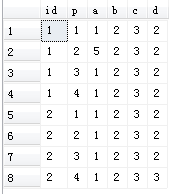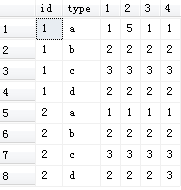将表1转化成表2:

表1

表2
得到表2的结果,需要经过多次pivot转换,再经union连接到一起,代码如下:

1 select id, type,sum([1]) [1],sum([2]) [2],sum([3]) [3],sum([4]) [4] from 2 ( 3 select 'a' as type, * from Table_1 4 pivot(sum(a) for p in([1],[2],[3],[4])) as a 5 union all 6 select 'b' as type,* from Table_1 7 pivot(sum(b) for p in([1],[2],[3],[4])) as b 8 union all 9 select 'c' as type,* from Table_1 10 pivot(sum(c) for p in([1],[2],[3],[4])) as c 11 union all 12 select 'd' as type,* from Table_1 13 pivot(sum(d) for p in([1],[2],[3],[4])) as d 14 ) t1 15 group by id,type 16 order by id,type
此时代码看起来比较多,如果需要n多次pivot转换,代码过于繁多。
此时,可通过定义一个变量,以拼字符串的形式,来代替繁多的代码:

1 declare @str varchar(8000) 2 set @str = '' 3 select @str = @str + ' SELECT '''+ NAME + ''' AS TYPE,* FROM Table_1 pivot(SUM('+ NAME +') 4 for p in ([1],[2],[3],[4])) as '+ NAME +' union ALL ' 5 from syscolumns 6 where object_id('Table_1') = id AND NAME <> 'P' AND NAME <> 'ID' 7 select @str = left(@str,len(@str)-len('union ALL')) 8 select @str ='select id, type,sum([1]) [1],sum([2]) [2],sum([3]) [3],sum([4]) [4] from ('+ @str +') t1 group by id,type order by id,type' 9 exec (@str)
两种方法得出的结果是一样的,只是后者代码更为简洁。
